Project Management with a Bit of Magic
Plan, manage, and deliver projects efficiently. Merlin Project for macOS and iOS
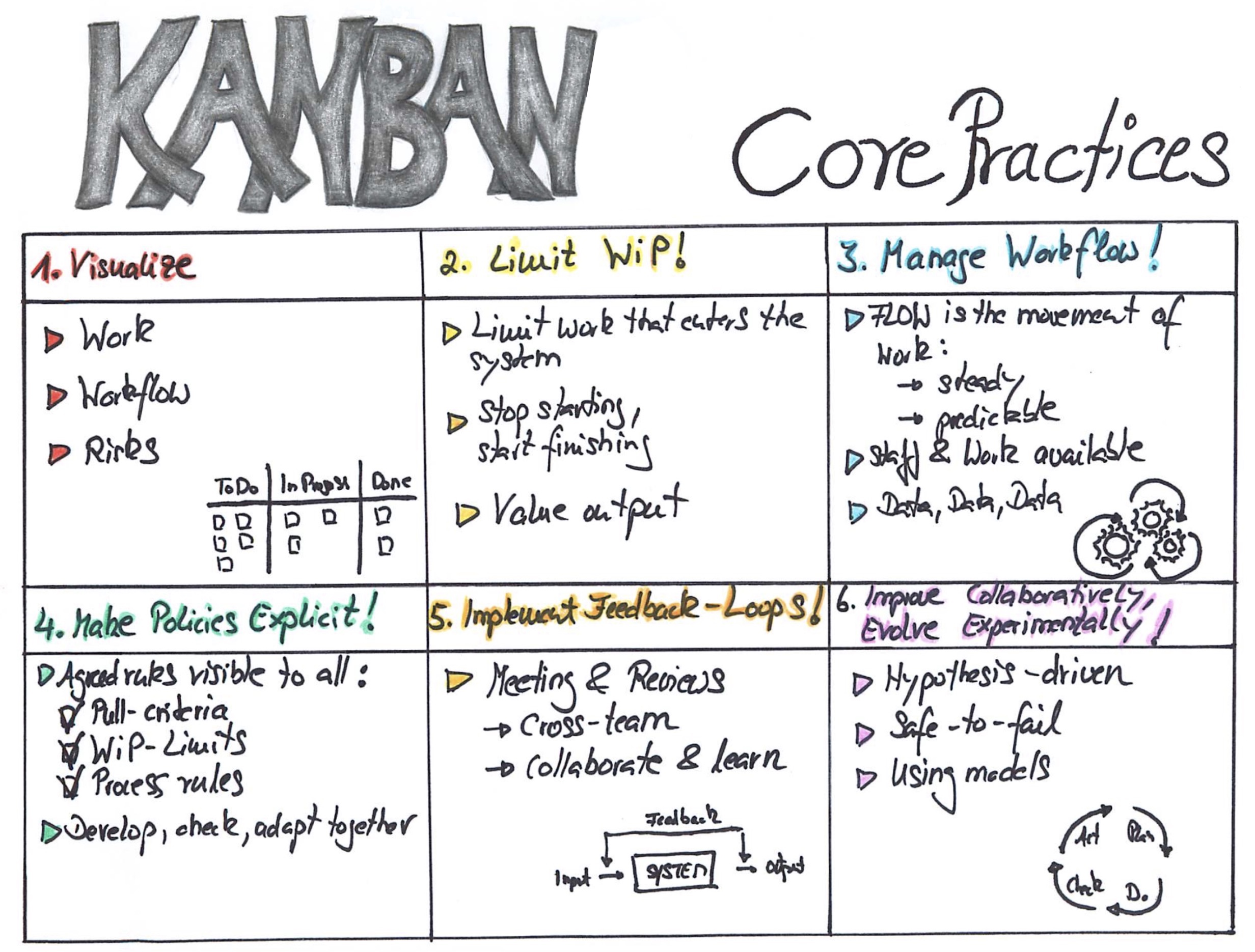
This article provides managers in service companies with an insight into how to use the Kanban method to tackle organizational difficulties. In the previous article Kanban in Organizations Part I you got to know the values and basic principles of Kanban. The basic principles describe how you should approach change in companies. Kanban's six core practices show you how to continuously provoke change. They also define important activities to manage and improve Kanban systems.
The basis for this article are the books „Essential Kanban Condensed“ by David J. Anderson and Andy Carmichael and „Kanban from the Inside“ von Mike Burrows.
Using the Kanban method, you can define, manage, and improve organizations that provide value-oriented services to customers as systems. In knowledge work, you do not deliver physical goods, but information in different forms. You view the associated processes as a sequence of knowledge determination steps with their associated process rules, which you map on a Kanban board.
Kanban boards are special workflow systems in which work packages flow through different stages of a process from left to right. To be considered a Kanban system, they must fulfill several conditions. They must have signals that restrict the so-called parallel work or WIP (Work in Progress). And Kanban systems must mark points for commitment and delivery. A commitment is an explicit or tacit agreement between the customer and the service provider, in which:
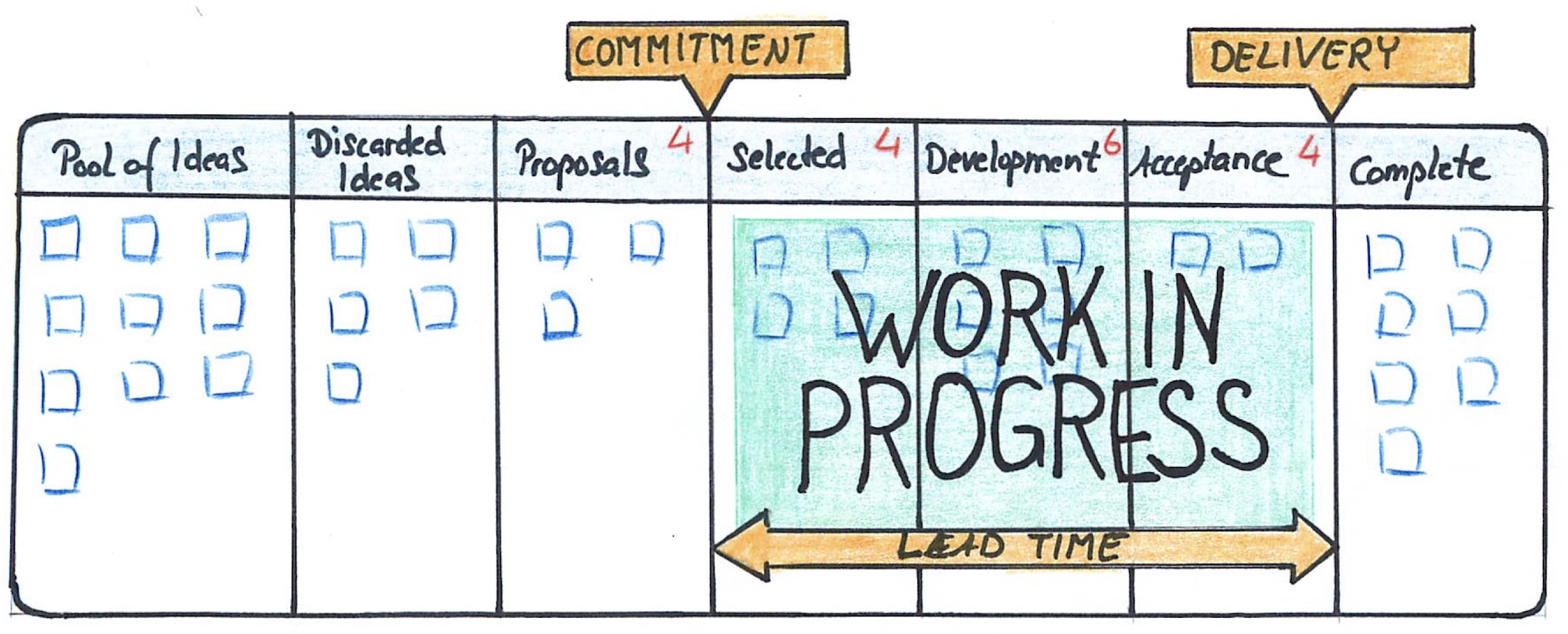
The number of work packages that are between the points for commitment and delivery in the system is the parallel work (WIP). In this Kanban board, the optical signals that limit parallel work (WIP) are derived from the composition of the cards, the WIP limits (in boxes above the columns), and the corresponding column. The (system) cycle time of a work package is the time it is in this range. It is important that you process the work packages in a Kanban system according to the pull principle, depending on capacities or capabilities. It should not be the customer who assigns the work (push principle). To improve the lead time for work packages, you must limit the parallel work (WIP) in your system. This is one of Kanban's core practices.
There are six core practices in Kanban.
These practices contain two important points:
See the work and process rules that determine how it is executed.
Improve the process evolutionarily by maintaining, strengthening and learning from useful changes and mitigating or reversing ineffective changes.
According to Mike Burrows, the individual core practices can be assigned to the Kanban values of transparency, balance, cooperation, Customer Focus and workflow.
The core practices Visualize, Make policies explicit and Implement Feedback Loops relate to Transparency.
You implement Kanban systems using a Kanban board. This visualizes the entire work process (Transparency). A Kanban board is a whiteboard with sticky notes or an electronic board with corresponding icons. The sticky notes or such icons on an electronic board are called Kanban, which stands in Japanese for visual signs or placeholders. The common English terms are card, ticket or work package, depending on whether it's about visual design and what they represent. You move the tickets on the board from column to column as the work progresses in the underlying work package.
In a service organization, work packages stand for defined parts of knowledge work such as service requests that you must fulfill. They exist in many different areas: in legal departments, human resources, sales, and the managing director's office. What they have in common is that this work is done in people's heads or on computers and is not visible without a Kanban board.
On a well-structured Kanban board with a clear ticket design you can easily see:
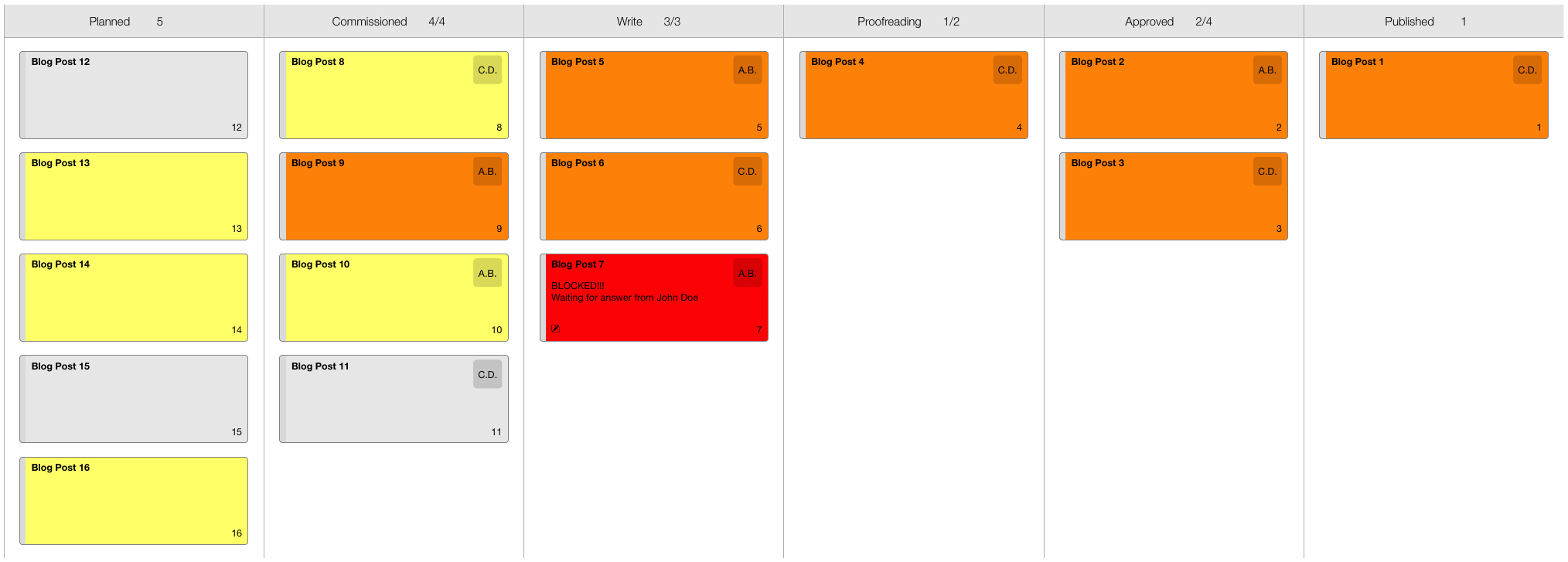
If this information is permanently available to you, you will quickly develop a feeling for a healthy state of the system. You will see immediately when things deviate from the norm and when you need to find out how to correct them.
The Kanban visualization should make on the one hand the demand for taking action visible and on the other hand help employees to make good decisions. This works on two levels:
Actions as work packages which need to be done, require decisions about the selection of the packages.
Actions changing the system require decisions in the justification, scope and introduction of change.
By triggering actions and supporting good decisions, Kanban leads employees to more mature behavior. If the Kanban board indicates that things aren't proceeding as they should, there are various ways for the management to respond. Statements like Do you understand why things turned out this way? Do you want to change the system accordingly? How should I help you? or I respect your ability to make appropriate changes in this situation reflect a leadership style that supports more mature behavior. Organizations that consciously accept these behaviors of their employees and promote this leadership style are well on the way to higher maturity.
The above mentioned statements contain self-organisation as another important element. Self-organization not only for the individual employees allowing them acting autonomously, but also for the system which can be reorganized and adjusted in order to deal more effectively with its challenges. For system operation as well as for system change, self-organization is both effective and humane.
A visually managed system can be changed quickly and cost-effectively: Erase one or more lines on the whiteboard, draw in another stickers and move a few. Or perform a few clicks with the mouse if you are working with software. The impact of these small changes can be enormous. Compared to the rather low implementation effort, this work on the system is an high leverage activity.
It's a virtuous circle:
A purely visual language in the form of tickets and columns and the like is sometimes not enough. Sometimes a few words about the process rules make the difference. They are a way for employees to maintain a common understanding of how they operate the system and can be more effective than regulations on a 'top-down' basis.
In addition to the strategy of making the invisible visible (visualize), you make the implicit explicit in the form of process rules. This is another aspect of the value Transparency. You only use process rules if it helps to make better and predictable decisions. You should not write extensive documents. A few carefully chosen words that express an intention are sufficient. Sometimes a single word above a Kanban column is enough to support an effective working agreement.
There are various process rules:
You cannot apply these rules universally, but you can transfer them to comparable contexts. There are rules that are unique to a situation. The context is important. Start with simple process rules that reflect current practice and refine as needed: Start with what you are doing makes sense here.
The original draft of the Kanban method contained no feedback loops. But they are essential. Early feedback helps you and your staff not to overlook or ignore the signs that your Kanban system is unhealthy. Through feedback loops, Transparency becomes an effective and targeted driver of change.
Standup meetings offer the opportunity for different types of feedback. These are regularly held meetings (mostly daily) that are so short that all participants can and should stand comfortably for the duration. They can have different formats, whereby we concentrate on the board-centered meetings:
You go through the work packages on the Kanban board from right to left and start with those that are close to completion. End the meeting if it seems unproductive to go further left on the board.
Or you go through the board as above from right to left and discuss the work packages that block the workflow or are risky.
These two meeting formats support the goal of making your decisions more transparent:
They also contain a social aspect that helps you building your team. The individual team members not only learn what is going on overall through these regular meetings, but they also get an insight into the work of the other team members. This way they better understand the needs of the team members and the communication becomes more direct and honest through the built up trust.
Another common form is the Replenishment Meeting. This is the discussion round where you fill the Input queue (Backlog) with new work. Since it provides an external view by the customer, it is an important feedback cycle. However, replenishment meetings are very contextual. Design their flow and frequency to suit the situation.
There are also other meeting formats that help manage the improvement process or provide it with data. The retrospective at team level is popular. Further forms are Service Delivery Reviews and Operations Reviews. Several teams share their data with each other and with the customer regarding the improvements they have made. The goal of these meetings is to create conditions in which you can generate quick feedback and act effectively.
The value Balance is closely related to Kanban's second core practice Limit the Work-in-Progress (WIP).
The WIP limits on a Kanban board serve as a coordination mechanism to implement a pull system. When you set a WIP limit for a column, you limit the number of work packages that it can contain. If a column contains the maximum number of tickets according to its limit, it cannot receive anything more. Its capacity is exhausted. If you move a ticket from this column further to the right because it has been processed in this area, a free space is created again. This has an important meaning: It signals availability. You can again pull a ticket from the previous column.

That's how pull systems work: The work moves on the board to the right towards completion. This causes the availability signals to move to the left (upstream). Further work packages can move forward to the vacated position as soon as they are ready. In those areas of the system where you have a row of columns with WIP limits, these signals move rapidly upstream. The entire system is linked. Without WIP limits there are no pull signals.
The signal flow stops when it reaches a column without a limit.The period of time that a work package needs to move through this entire system is the lead time of the Kanban system. It is sometimes very different from the lead time that you measure from the customer's point of view.
Balance of work load and capacity:
A Kanban board, which contains columns with WIP limits, ensures for the responsible employees in the corresponding areas that the amount of work does not exceed the capacity. This prevents employees from being overloaded. If you prioritize completing tasks over starting new work, you improve quality by improving focus. In addition, there are fewer work packages in the entire pipeline, which allows you to complete the work much faster and receive feedback much earlier.
Occasionally you'll get the impression that the WIP limits are set incorrectly. Use these situations to start discussions and research. If the limits are too high, work packages get stuck because employees are missing to process them. If you choose too low limits, employees will not have enough work and the system will stagnate. Investigate the reasons for this, rather than prematurely adjusting the limit.
WIP limits do not just serve as levers to enforce rules. Rather, they can be seen as mechanisms for feedback and drivers for system-wide improvements. If you reduce the work in progress, other problems become much clearer. If you fix these, you can further reduce the WIP.
But if you assume that you need to employ new people first, this does not solve the problem of blocked work. Instead, start new work and increase the Work in Progress in your system. This means waiting more often for others to finish up and the problem gets worse. Delays and multitasking have a negative impact on quality. This leads to more rework and blockages and the work in progress increases more and more.
Balance of urgent and on-time work:
Particularly for knowledge work, not all forms of work are the same. There are work packages driven by deadlines and urgencies. You must deliver time-driven work packages at a certain point in time. If the delivery takes place too late, it can become expensive for your organization. If you deliver earlier, there is no added value, but it could be detrimental. For urgency-driven work packages, the sooner you deliver, the earlier you or others can benefit. It is most effective if you deliver the urgent work before the scheduled work. Prioritize the on-time work when the deadline is at risk. If you handle these types of work packages in this way, you will get good results.
For some work packages it is difficult to make a safe decision. They are neither time-bound nor urgent. You'll have to take the risk and experiment. Do the longer-term work in the background (risk-based categorization). This is the only way you can develop the product, process or employee skills.
You can also categorize your work packages according to different service promises, so-called service classes. They help the customer to select the service class that is best suited to his or her needs and best represents the balance between risk and outcome. Within your organization, planning rules guide the decision as to which work packages you work through with which priority in order to achieve good results. With a healthy mix of different types of work, you can make and maintain accurate predictions. It is important to consider sufficient buffers of immaterial and standard work.
With Kanban's core practice Improve Collaboratively, Evolve Experimentally you promote and improve Collaboration in a targeted way. To understand how this core practice relates to the value of cooperation, you need to look at the extended formulation:
Improve Collaboratively, Evolve Experimentally (use models and the scientific method).
The importance of cooperation becomes clear when you look at concrete examples of famous creative cooperations. Consider the collaboration between Marie and Pierre Curie. It was a cooperation that had an enormous impact. It wasn't just people working together in general. Rather, it was a relationship in which creativity as a whole was greater than the sum of its parts. Unfortunately, you can't expect every workplace cooperation to be so spectacularly productive.
An effective organization is expected to use cooperation in the delivery of its products and services. In this sense, the first part of the 6th core practice improve objectives cooperatively means that part of the creative energy is used to optimize the underlying delivery system.
From the point of view of cooperation, the concepts of feedback cycles and self-organisation, which belong to the value of Transparency, take on a different meaning. Feedback cycles involve several people working together (cooperatively) on one thing. And when teams work self-organized, improvements and innovations develop from collaborations that arise from the fact that the appropriate group of employees is automatically involved. However, continuous self-organized improvement does not simply develop overnight. It is important that you encourage cooperation and focus on it. We will explain later what role leadership plays in this.
It's useful not only to look at the number of interactions in a work process or the order in which they take place. It is important that you also focus on the quality of the individual interactions. This is to be understood as an independent strategy and not as a pure technique, which you use in the context of a certain improvement possibility. It is important to identify key processes that are slowed down by low quality interactions, delays, back-and-forth conversations, rework and frustration. In addition, you will try to find out if there are employees or teams who rarely have the opportunity to engage in quality collaboration. If you recognise this, you can increase the creativity of your organisation.
If something surprises or frustrates you, ask yourself whether it can be due to the lack of cooperation. Even if it may at first look like a mistake by a single person or a mistake in a process.
In summary, Improve Collaboratively stands for how you drive change. The second part of the 6th core practice Evolve Experimentally, on the other hand, stands for how you implement change. The Kanban method is based on the concept of a process for problem solving. You apply this process repeatedly in an improvement cycle. The Kanban community uses the PDMA, also called Deming cycle or Deming circle/wheel, where the first letters stand for Plan, Do, Check, Act. It is important to use the individual terms in connection with the term experiment:
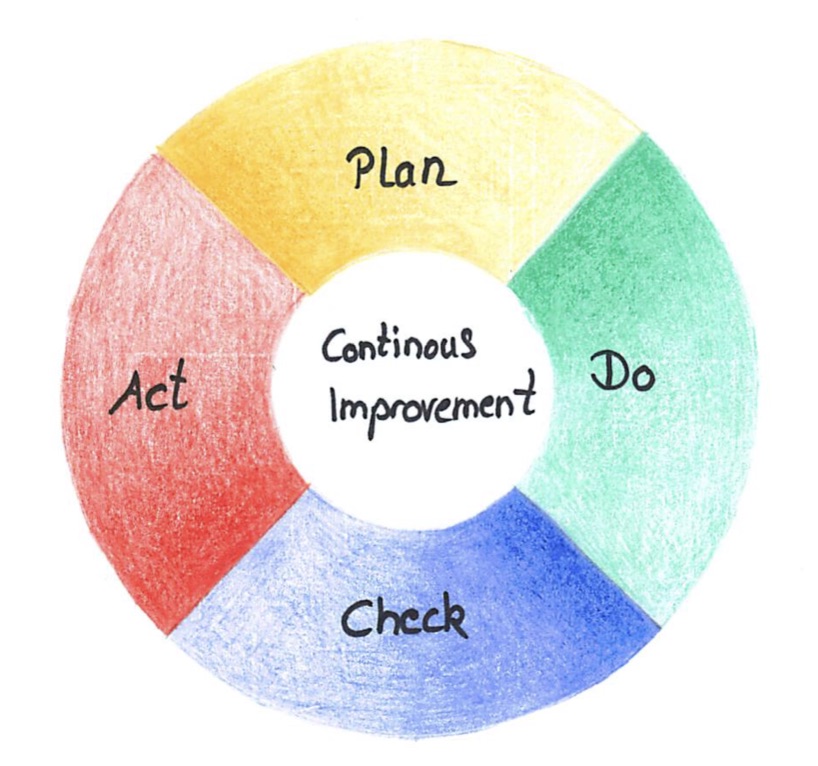
You need a high degree of discipline to implement changes according to scientific procedures. As a result, you give the concept of result-oriented work within your organization an additional new meaning.
To better understand the meaning of core practice 3 Manage Flow, you need to expand it a little:
Manage the workflow to achieve consistency, punctuality and good economic results, while anticipating customer needs.
This formulation clearly shows to what extent the third core practice is linked to the value Customer Focus:
There are several things you should pay attention to when doing your work: Task focus, team focus, product focus, technology focus and so on. Focusing on the customer helps you put these no less important points of view into perspective. We will show you below how Customer Focus can optimize the workflow. Since if you look at your work from someone else's perspective, you are likely to learn something new about how it operates.
Let's take an example from software development: A team of developers had created a process that seemed effective enough. They collected requirements, built new functions, tested them and released them. After some time, the team became more demanding. To track the new features, they added another column to their board. These new features were already released, but further steps were needed to make them complete. Too often, the team found out that it was delivering features that the (in this case internal) customer never used. And this, although the functions were desired by him. So a new process rule developers remain responsible for work packages until they receive feedback from the customer that the packages are proving valuable was added.
This process rule was aimed at the allegedly poor customer behaviour; The customer isn't telling the team when he changes his mind. This new process rule quickly changed the behavior on both sides. Closing a feedback loop accelerated collaboration with the customer. Developers and internal customers jointly created the final implementation steps for the new way of working together. In fact, because success seemed to depend on a shared commitment, it even changed how work was prioritized at the beginning of the process. Ultimately, it wasn't the customer that was bad, but the relationships weren't effective enough.
In the example described above, the catalyst was a process rule that we added to the right column of the Kanban wheel. It transferred the value Customer Focus to the whole process. To transfer such implementation to your processes, look at your board with a few specific questions. From right to left and column by column:
Whose needs are examined in this part of the process? Whose needs are not addressed and what are the risks? (Also treat internal stakeholders as customers if they have a veto right.)
What do we learn in this phase that we could not already know or learn in an earlier phase? In what way do the activities in this phase help us to achieve what we need or the customer needs?
What else do we need to learn? Can we better address ambiguities going forward or backward in the process?
By working with this logic at the beginning of the process, you develop knowledge so that you meet customer needs which you still have to discover and explore. It is no longer a matter of meeting given requirements. Don't overly trust a secure process to do your job. Instead, look for ways to learn more effectively. It's also about a mental shift from the past (what the customer originally told us) to the future (when you've met the customer's needs). Creative knowledge work is a process of knowledge development. Use your Kanban board to remember it over and over again: What do we not know?
If we look again at the extended core practice 3 Manage workflow to achieve consistency, punctuality and good economic results, and anticipate customer needs, we acknowledge that consistency of delivery and punctuality play an important role in the value of Workflow.
Manage the workflow to achieve consistency of delivery:
Consistency of delivery has a high esteem in the Kanban method. In some circles it borders on obsession, as the manager training at Toyota shows. The prospective managers observe production lines for hours and look for the slightest deviation from the ideal of uniformity. It becomes clear that you can and should improve any production process, no matter how smooth it is.
We begin with the question: How do we recognize that work begins to be in progress? There are a few signs of this:
A good number of work packages move between regular stand-up meetings. How many exactly and how often depends on the size of the work packages, the team size and the distance between meetings. It often feels reassuring to see movement every day. If progress is not well visible, it is advisable to divide large work packages into smaller (but valuable) work packages.
A good number of work packages are recognizably free of blockages relative to the number of available employees, so that current and future progress can be recognized.
You feel (and measure if necessary) that employees are completing work faster and more predictably. The lead times for work packages of the same type and size become shorter and they move within a narrower range.
If you cannot see these signs in your work process, you have a goal. If you think you can see these signs, ask yourself if you can further improve this workflow in terms of these broad measurement criteria.
In order to further improve your workflow in terms of consistency of delivery, you should also work backwards here. It forces you to focus on what you need for work to flow. Start again on the right side of your Kanban board and consider what keeps the work from sliding smoothly across the board to completion. Focus on the flow of work and ask yourself the following questions for each column:
How do work packages leave this process step? What criteria tell us that they are ready? How is this readiness signaled so that downstream action can be taken?
How much time do work packages usually spend in this state? How much time do they spend in active work as opposed to just waiting?
What are the biggest sources of unpredictability? Do they have their origin in work or waiting time? Are the relevant units waiting for internal availability or for external dependencies to dissipate?
How much capacity in this state is consumed by rework?
How do work packages arrive in this state? How do we know that they are ready for processing?
Both values Customer Focus and Workflow invite teams to consider a broader context. Kanban is not about individual production or team production alone. This means you shouldn't limit yourself to the problems you can solve alone. Rather, it challenges you to work with other people on larger problems that run through the overall system. Collaboration does not only help you to finish things. It ensures that your collaborative efforts focus on the essentials.
Manage the workflow to achieve punctuality:
Besides consistency of delivery, punctuality also plays an important role for the value Workflow, as the above-mentioned extended core practice 3 Manage the work flow to achieve consistency of delivery, punctuality and good economic results, and anticipate customer needs demonstrates.
The management of the workflow does not only consist of the removal of emerging obstacles. In knowledge work, the work packages differ greatly from one another in terms of both content and value. In addition, the workload fluctuates enormously over the course of time. So there is always a place where you can actively control work.
Although Kanban has committed itself to self-organization, it is advisable to accompany the most important work packages more closely. Some work packages deserve more attention from management than others. Especially important deadlines should be met. It's okay for high-value work packages to bypass queues if you can justify it with a business benefit, even if overall predictability suffers.
The Kanban value Leadership needs Transparency, Balance, Collaboration, Customer Focus and Workflow. With these values, we have introduced the six core practices of the Kanban method:
Each of these practices opens up many opportunities for you to exercise leadership.
The remaining values of Understanding, Agreement and Respect are each to be seen as one area of leadership and represent three of Kanban's four basic principles*:
These principles firmly anchor the Kanban method as an evolutionary approach, both technically and ideologically. They also describe some important commitments and behaviors of leadership that are fundamental to its implementation and ongoing operations. Thus, leadership builds the bridge between these two sets of values and connects Kanban's core practices to its basic principles.
The fourth basic principle is called:
BP4: Encourage acts of leadership at all levels.
This principle is integratively formulated. It respects the current structure of your company and does not exclude anyone. Moreover, it does not impose any false dichotomy between leadership and management. It is anchored as a basic principle in the Kanban method. This gives you the indication that it is of fundamental importance to cultivate this kind of leadership at all levels. What if this type of leadership is not a part of your business? Kanban is a process of constant change for the better. When change is stimulated, small and larger opportunities for leadership reveal themselves. And the more far-reaching this process is and the better it can be visualized and reproduced, the more positive the impact on your corporate culture will be.
The agile Kanban method provides you as a project manager with an optimal tool. With Kanban you concentrate on the workflow and the completion of tasks. It can be easily introduced into existing organizational structures, as it respects the current roles, titles and hierarchies of an organization and triggers the improvement process from there. With Kanban, all types of work are captured and measured.
With the project management software Merlin Project you can create an agile workflow by using ready-made Kanban boards or you can divide your Kanban board according to your own requirements. The layout of the cards can also be individually designed. A new card can be inserted with a simple click. This will appear in the left column. You then enter the details for the task directly on the card and assign the resources to it using Drag & Drop. You can document your project progress by moving the task cards further to the right into the next columns. Each column has its own completion value.
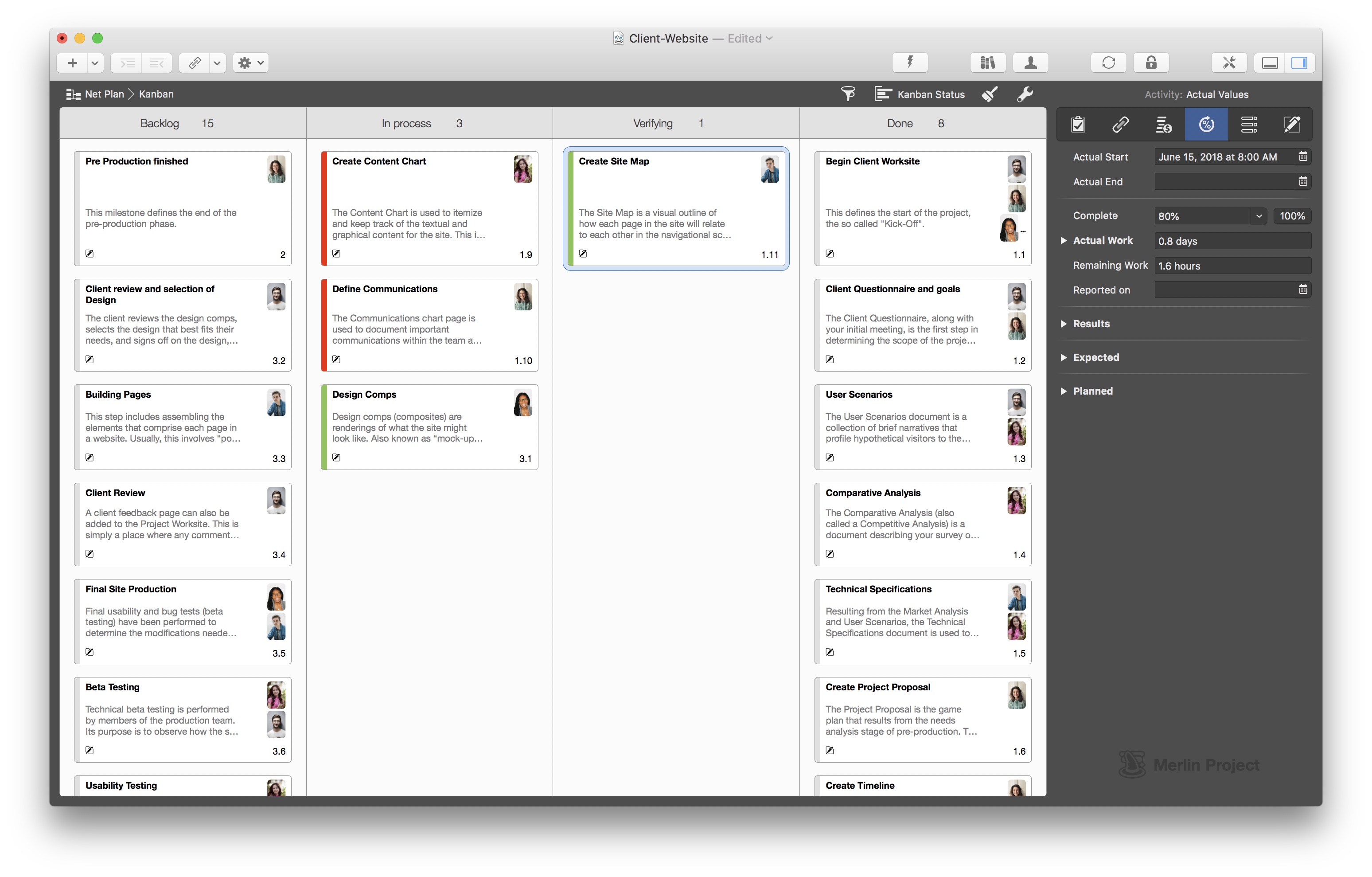
In Merlin Project you can create any number of Kanban boards as personal views. You define your own column sets including completion values, filters and groupings according to the requirements of your team members. Everyone can find their way around the project. The individual team members work on their respective tasks at the simplest level, while you keep track of them.
One of Kanban's goals is to master the complexity of a project and control the work in progress at the same time so that no bottlenecks occur. In Merlin Project, you can define the minimum and maximum number of cards for each individual column. And even use groupings for so-called "Swimlanes" which help to maintain an overview of large Kanban boards.
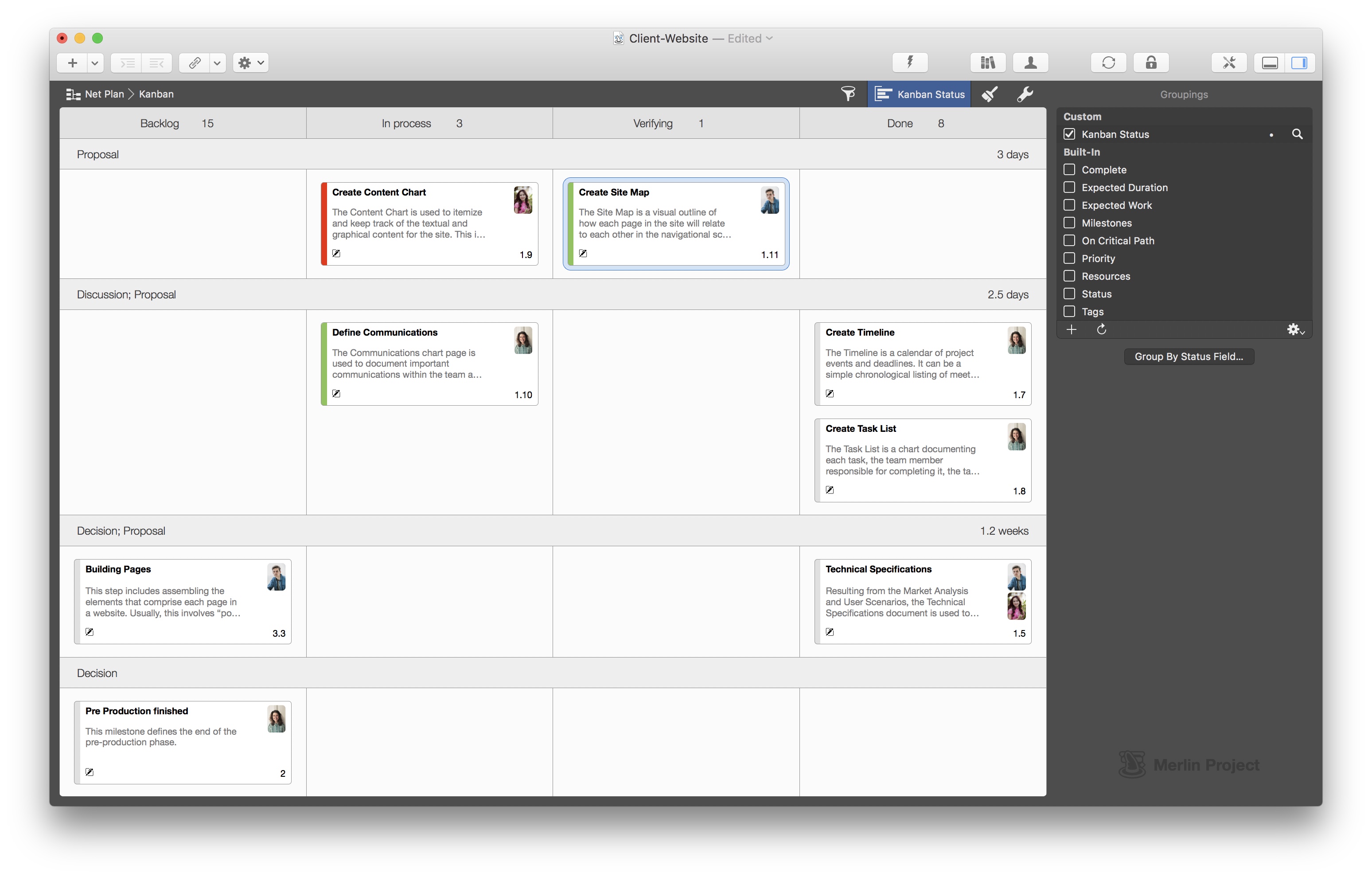
From a project manager's point of view, it is important that you always work first and as quickly as possible on the most important activities. This makes the entire project process smoother. Such behavior evolves from Kanban's six core practices:
Visualize your work: Visualizing the work is simple and offers great insights. The Kanban board provides a clear picture of the project team's workflow.
Limit the current work: The current work is the sum of all workflow parts. Kanban project management strives to limit ongoing work and encourage teams to work together to resolve bottlenecks and be more effective.
Manage the workflow: With Kanban project managers and their team can control the workflow more actively. They focus more on completing tasks quickly and less on starting something.
Make policies explicit: Work with a Kanban board having different categories for urgency, priority, and fixed deadline. The definition of service classes reduces rework and leads to more flexibility.
Implement Feedback Loops: Feedback loops make it easy to compare final with actual results to make adjustments. In Kanban, feedback is implemented between teams to achieve better performance.
Improve Collaboratively, Evolve Experimentaly: As the project team can visualize the workflow with the help of Kanban, it may jointly improve the workflow. Team members can discuss difficulties, suggest changes, make, and encourage improvements.
Stop Starting, Start Finishing! That's what projects really need. It prevents tasks from being completed for an extended period of time up to 90, 95, 98 percent, but not completely completed.
Kanban will not solve all challenges in managing your projects. There will always be decisions, dilemmas and complexity that no method can solve. But Kanban can make your life as a project manager easier and help you succeed with your projects.
*In 2016, D. Anderson and Lean Kanban University expanded the Kanban Principles from four to six and divided them into the Change Management Principles and the Service Delivery Principles, to separate service delivery from change management.
Your ideas, our magic – make projects easy! Test now 30 days for free.
